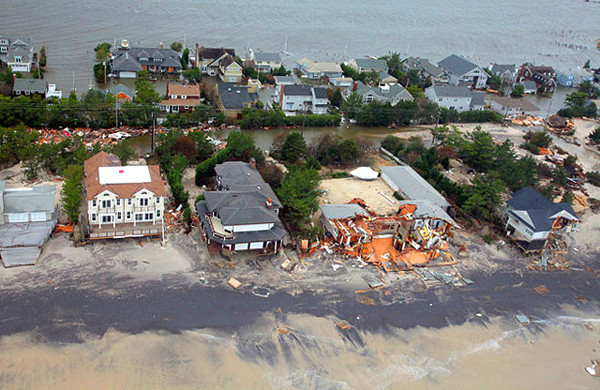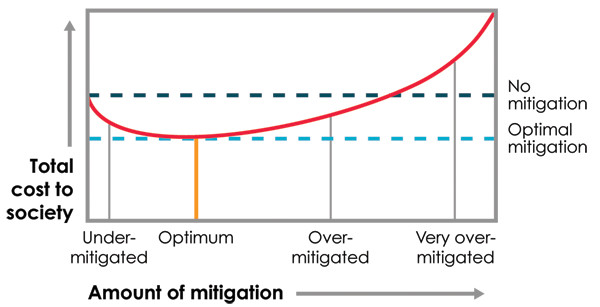
by Seth Stein Thursday, October 30, 2014

Aerial views of the damage caused by Hurricane Sandy to the New Jersey coast. Credit: New Jersey National Guard.
After Hurricane Sandy caused about $65 billion of damage to the U.S. East Coast in 2012, the question of how to reduce damage from future storms came under extensive discussion. This question illustrates the complexity of preparing for natural disasters.
Preparing for natural disasters is a challenge described in terms of the occurrence of natural hazards like hurricanes, earthquakes or other phenomena, versus the risks or dangers they pose to lives and property. The risk is the product of hazard and vulnerability. As a society, we want to assess the hazards — estimate how significant they are — and develop methods to mitigate or reduce the resulting losses.
Hazards are facts of life that are not under human control. In contrast, risks are affected by human actions that increase or decrease vulnerability, such as where people live and how they build. We increase vulnerability by building in hazardous areas and decrease it by making communities more hazard resistant. Disasters occur when — owing to high vulnerability — a natural event has major consequences for society.
For the New York City area, possible options for dealing with future hurricanes range from doing very little (a cheap option), to providing sealable doors to keep water out of vulnerable tunnels (moderate cost), to building up coastlines, preventing development in vulnerable areas and installing barriers to keep the storm surge out of rivers (expensive measures).
In general, more extensive mitigation measures should reduce further losses in future events, but will cost more up front. These measures are like buying insurance. We spend money today in hopes of reducing the consequences of possible future events.
Although our first instinct might be to protect ourselves as well as possible, reality sets in quickly, because society has finite resources. Resources used to mitigate potential hazards are not available for other purposes. Funding higher levees to reduce river flooding competes with plans to improve kindergartens. Money spent making school buildings earthquake-resistant cannot be used to hire teachers. Communities thus face the fundamental question of deciding how much mitigation is enough.
Prioritizing is always hard, but it is especially difficult for natural hazards, because of our limited ability to forecast the future. For example, the occurrence of hurricanes is highly variable in space and time, owing to the chaotic processes involved in forming and driving them. Formulating natural hazard policy should involve combining science and economics to analyze a problem and explore different options, recognizing that the future is uncertain. The analysis would ask: What is the problem? What do we know and not know? What are we trying to accomplish? What strategies are available? What are the costs and benefits of each? And what are sensible strategies given various assumptions and uncertainties? The results would help communities decide what to do and how to pay for it.
However, mitigation policies are usually chosen without such analysis. Typically, communities do not consider different options, and yet somehow choose one (or have one chosen for them) without knowing how much they’re paying or what they’re getting for their money. This is like buying insurance without considering how much a policy would cost and what the benefits would be. Not surprisingly, the results are often disappointing.
A striking example involves California hospitals. After the collapse of hospitals in the 1971 San Fernando earthquake killed about 50 people, the state required that hospital buildings be structurally strengthened. This policy was adopted without considering “ts costs and benefits or how hospitals could pay for it. Although it assumed that retrofits could be done cheaply, analyses have shown that retrofitting costs are often comparable to new construction.”
Hence, more than 40 years later, most of the state’s hospitals do not meet the standard, and at least $50 billion would be needed to get them up to code. As California’s Secretary of Health and Human Services explained in a Los Angeles Times article in 2007, “A seismically safe hospital building is no good to anyone if the doors close due to a hospital’s financial inability to replace or retrofit that building … Policymakers have to look at future seismic safety risk against today’s realities of access and financial capacity.” Moreover, as one doctor mused to me, “we could treat a lot of people for $50 billion.” A tough question is whether more lives would be saved by retrofitting hospitals or by using the funds for patient care.
A similar situation involves Los Angeles’ many older concrete buildings that are not ductile enough to withstand the shaking of a large earthquake and so might collapse. For decades, debate has raged about requiring that these buildings be strengthened. However, many tenants — including me during my graduate school days — would not or could not pay more for safety, so property owners could not pay the high cost and stay in business. Putting them out of business would reduce the supply of inexpensive housing and office space. Property owners would have to pay for safety that does not directly benefit them. They and their tenants would bear the costs, but the benefit of safer buildings is to the benefit of the whole community. A rational approach would be to calmly consider the costs and benefits of retrofitting or demolishing the buildings, and — depending on what a community decides to do — how to pay for it.

Curve showing how the total cost to society of natural disasters depends on the amount of mitigation. The optimal mitigation level minimizes the total cost, the sum of the expected loss and the mitigation cost. Credit: Seth Stein and Jerome Stein.
In choosing among mitigation options, communities operate under several major constraints. First, given the complexities of nature, estimates of hazards are inadequate. Second, resources to allocate between hazard mitigation and other needs are limited. Third, a wide range of societal, political and economic issues must be considered.
My colleagues and I have looked at ways to compare options. The total cost of natural disasters to society is the sum of the expected loss in future disasters and the cost of mitigation. This total depends on the amount of mitigation, shown schematically by the U-shaped curve in the figure above. If we undertake no mitigation, we have no mitigation costs (left side of the curve) but we expect high losses — so it makes sense to invest more in mitigation. Increased mitigation should decrease losses, so the curve goes down. Eventually, however, the cost of more mitigation exceeds the reduction in losses, and the curve rises again — the additional resources required would do more good if invested otherwise. The optimum amount of mitigation is the “sweet spot” at the bottom of the curve.
Because there are large uncertainties in our ability to assess the hazard of natural disasters and the resulting losses, graphs provide schematic ways to guide our thinking, rather than precisely computed equations. Although it would be unrealistic to claim we can actually find a single optimum strategy, even simple estimates can show which strategies make more sense than others. Thus, although in real cases we cannot give an optimum strategy, we can identify sensible strategies.
Mitigation policy decisions are made politically, and involve sociocultural preferences, so they are unlikely to be optimal from a purely economic standpoint. Society is sometimes overly concerned about relatively minor hazards, yet it downplays more significant ones. Much more is spent trying to protect against exotic risks like rare diseases or terrorism, for example, than on much greater but familiar risks like traffic accidents or common diseases. Only about a third of U.S. adults get shots to protect against the flu, despite influenza and pneumonia together being the eighth leading cause of death in the U.S. every year. On the other hand, it’s not clear how many lives, if any, are saved by the U.S. Transportation Security Administration, which has 60,000 employees and a budget of $8 billion, mostly to screen airline passengers who are very unlikely to be terrorists. In fact, researchers find that the inconvenience and unpleasantness of airport security cost lives, because some people choose to drive — a far more dangerous activity — rather than fly. Hence, in some cases we spend more than makes sense, and in others we spend less.
Fortunately, there is a range of nonoptimal mitigation solutions that is still better than no mitigation at all. So long as we choose a point on the total cost curve below the dashed line showing the cost of no mitigation, there is a net benefit to society. Mitigation only does more harm than good in the extreme case of over-mitigation, where the curve is above the “no mitigation” line, showing that more is being spent to defend against disaster than the effects of the disaster would cost.
This analysis raises two approaches we should pursue. First, we should try to better assess hazards, recognizing and understanding the uncertainties involved, and communicate these uncertainties to the public and planners formulating mitigation policies. Second, mitigation policies should be developed by considering the uncertainties in the hazard and loss estimates, and the costs and benefits of alternative strategies. Both approaches are challenging, but would significantly improve our ability to deal with natural hazards.
© 2008-2021. All rights reserved. Any copying, redistribution or retransmission of any of the contents of this service without the expressed written permission of the American Geosciences Institute is expressly prohibited. Click here for all copyright requests.